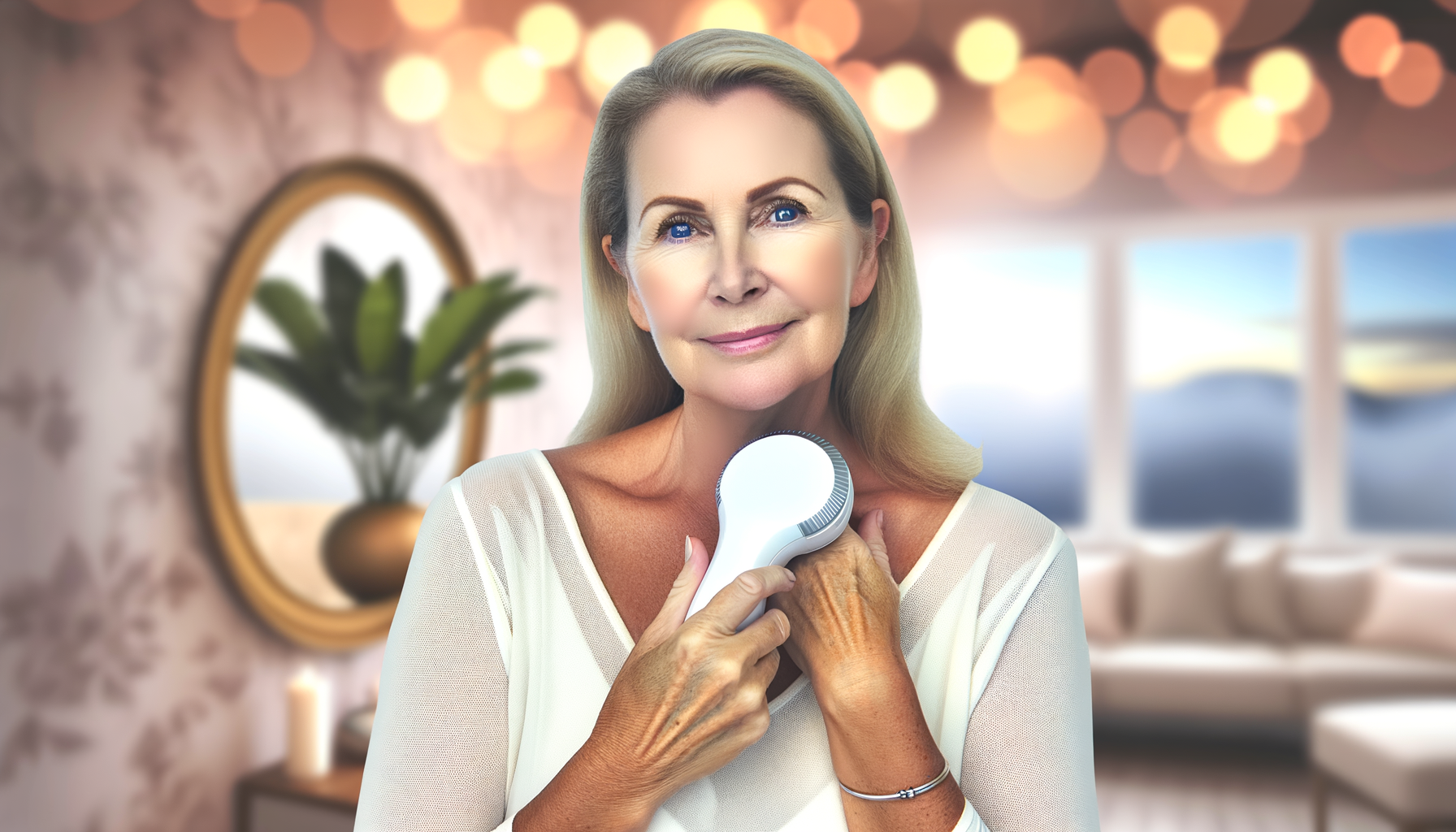Introduction to Menopause and Skin Health
Understanding Menopause and Its Impact on Skin
Menopause marks a significant transition in a woman’s life, typically occurring between the ages of 45 and 55. It signifies the end of menstrual cycles and is confirmed after 12 consecutive months without a period. Menopause is a natural biological process, but it can lead to various systemic changes, including those affecting the skin. The decline in estrogen and other hormones can significantly impact skin health, leading to noticeable changes in skin structure and function.
Common Skin Changes During Menopause
- Decreased elasticity and firmness: The reduction in collagen and elastin production during menopause can lead to skin that is less resilient and more prone to sagging.
- Dryness and roughness: Menopausal skin often becomes drier and may feel rough to the touch due to decreased natural oil production and impaired barrier function.
- Increased wrinkling: The loss of supportive skin structures, combined with years of environmental exposure, often results in more pronounced wrinkles and fine lines.
- Thinning of the skin: The epidermis and dermis can thin out, making the skin more fragile and susceptible to injuries.
- Pigmentation changes: Women may notice age spots or uneven skin tone as a result of hormonal changes and accumulated sun exposure.
The Importance of Skin Care in Menopausal Women
Given the substantial changes that menopausal skin undergoes, it’s crucial for women to adapt their skincare routines to address these new challenges. Proper skin care can help mitigate some of the negative effects of menopause on the skin. This includes using products that promote hydration, support the skin’s barrier function, and provide adequate sun protection. Additionally, treatments that stimulate collagen production, such as radiofrequency, can be particularly beneficial during this time.
Radiofrequency treatment stands out as a non-invasive option that can help tighten and rejuvenate the skin by stimulating collagen and elastin production. As we delve deeper into the benefits of this treatment, it’s essential to understand the unique needs of menopausal skin and how advanced skincare techniques can provide relief and improvement in skin health and appearance.
Overview of Radiofrequency Treatment
What is Radiofrequency Treatment?
Radiofrequency (RF) treatment is a non-invasive cosmetic procedure that uses energy in the form of radio waves to heat the dermis, the deepest layer of your skin. This heat stimulates the production of collagen, the protein that gives your skin its firmness and elasticity. As a result, RF treatment can improve skin laxity, reduce wrinkles, and promote a more youthful appearance without the need for surgery or extensive downtime.
The Evolution of Radiofrequency in Skin Care
The use of RF in skin care has evolved significantly over the years. Initially, RF treatments were used to treat conditions such as chronic pain and certain types of tumors. However, the discovery of its skin-tightening capabilities has led to its widespread use in cosmetic dermatology. Today, RF treatments are performed using a variety of devices, some of which combine RF with other technologies such as microneedling or ultrasound to enhance results. The versatility and safety profile of RF treatments have made them a popular choice for individuals looking to address skin aging concerns.
Comparing Radiofrequency with Other Skin Tightening Treatments
- Non-invasive nature: Unlike surgical options like facelifts, RF treatments do not require incisions or anesthesia, making them a less invasive alternative.
- Minimal downtime: RF treatments typically require little to no recovery time, allowing patients to return to their daily activities almost immediately.
- Safety: RF treatments are generally safe for all skin types and tones, with a low risk of side effects when performed by a qualified practitioner.
- Gradual results: While some treatments like laser resurfacing can offer more immediate results, RF treatments provide gradual improvement over time as collagen production increases.
- Combination with other treatments: RF can be combined with other non-surgical treatments to target multiple skin concerns simultaneously.
Overall, RF treatments offer a compelling option for those seeking a non-surgical approach to skin tightening, with benefits that can rival more invasive procedures.

Popular Read: Endocrine Disruptors in Skincare: What You Need to Know
The Science Behind Radiofrequency and Skin Rejuvenation
How Radiofrequency Works on a Cellular Level
Radiofrequency (RF) treatment is a non-invasive method that uses energy waves to heat the deep layer of your skin known as the dermis. This heat stimulates the production of collagen and elastin, the scaffolding of the skin, and promotes cellular turnover. On a cellular level, RF energy causes the molecules within the skin to vibrate, generating heat. This heat induces thermal damage without harming the epidermis, or the outer layer of skin, which triggers the body’s natural healing response.
Collagen and Elastin Stimulation
Collagen and elastin are vital proteins that maintain the skin’s structure and elasticity. As we age, production of these proteins diminishes, leading to sagging and wrinkles. RF treatment, however, can stimulate the fibroblasts—cells responsible for collagen and elastin production—thereby initiating the synthesis of new fibers. This process, known as neocollagenesis, helps to restore the skin’s youthful appearance by improving its texture and firmness.
The Role of Heat in Skin Tightening
The application of controlled heat during RF treatment plays a crucial role in skin tightening. When the skin is heated to a certain temperature, existing collagen fibers contract, causing an immediate tightening effect. Moreover, the heat disrupts the hydrogen bonds in the collagen triple helix structure, leading to an immediate denaturation and contraction of collagen fibers. Over time, as the skin heals from this thermal injury, new collagen is produced, further enhancing the skin’s tightness and overall appearance.
Long-term Effects of Radiofrequency on Skin Structure
The long-term effects of RF treatment on skin structure are cumulative and progressive. With each session, the skin’s texture and tone continue to improve as new collagen and elastin fibers are formed. This results in a more durable skin matrix and a reduction in the appearance of fine lines and wrinkles. Additionally, the thermal energy can also improve blood circulation, leading to better oxygenation and nourishment of the skin, which further supports the skin’s regenerative processes. Over time, patients can expect to see a more lifted, firm, and youthful complexion, with results that can last up to several years, depending on the individual’s skin condition and aging process.
Benefits of Radiofrequency Treatment for Menopausal Skin
Improvement in Skin Tone and Texture
One of the most notable benefits of radiofrequency (RF) treatment for menopausal skin is the improvement in skin tone and texture. As estrogen levels decline during menopause, skin can become dull, uneven, and rough. RF treatment helps to rejuvenate the skin by encouraging the production of new collagen and elastin, resulting in a smoother, more even complexion. The gentle heating action of RF can also promote better blood circulation, which enhances the overall radiance and glow of the skin.
Reduction of Fine Lines and Wrinkles
Menopause often accelerates the appearance of fine lines and wrinkles due to the loss of collagen and elastin. RF treatment effectively addresses these concerns by delivering heat energy to the deeper layers of the skin. This stimulates the body’s natural healing response, leading to the formation of new collagen fibers. Over time, the skin becomes firmer and tighter, and the appearance of fine lines and wrinkles is significantly reduced, giving a more youthful and refreshed look.
Enhanced Skin Elasticity and Firmness
The decline in skin elasticity and firmness is a common issue faced by menopausal women. RF treatment can counteract these effects by tightening the existing collagen fibers and promoting the growth of new ones. The result is a noticeable lift and firmness in areas that tend to sag, such as the jowls, neck, and cheeks. With repeated treatments, patients can achieve long-lasting improvements in skin elasticity, helping to combat the gravitational effects that contribute to sagging skin.
Detoxification and Improved Blood Circulation
RF treatment not only improves the external appearance of the skin but also promotes internal health through detoxification and improved blood circulation. The thermal effect of RF energy helps to open up blood vessels, enhancing the flow of oxygen and nutrients to the skin while facilitating the removal of toxins. This improved circulation can lead to a reduction in puffiness and a more vibrant, healthy-looking complexion.
In conclusion, radiofrequency treatment offers a multitude of benefits for menopausal skin, addressing many of the common concerns associated with hormonal changes. By improving skin tone and texture, reducing the appearance of fine lines and wrinkles, enhancing elasticity and firmness, and promoting detoxification and blood circulation, RF treatment can help menopausal women feel more confident and comfortable in their skin.

Feeling You Have a Right to Safe Beauty & Fem Care?
If so, it may be time for a change. It starts with knowledge. We have a few suggestions in our new guides.
Is Radiofrequency Treatment Right for You?
Suitability for Different Skin Types and Tones
Radiofrequency (RF) treatment has been celebrated for its inclusivity, catering to a wide range of skin types and tones. The non-invasive nature of RF therapy means it can be safely used on all skin colors without the risk of hyperpigmentation, which can be a concern with certain laser treatments. However, individual skin conditions, such as thickness and underlying health, can affect outcomes. It’s essential to consult with a skincare professional to assess whether RF treatment aligns with your skin’s characteristics and your aesthetic goals.
Considering Hormonal Fluctuations During Menopause
Menopause brings about hormonal changes that can significantly impact skin health, leading to decreased collagen production and skin laxity. RF treatment can be particularly beneficial during this time as it stimulates collagen and elastin synthesis, helping to counteract the effects of hormonal fluctuations on skin firmness and structure. Nevertheless, it’s crucial to discuss your hormonal health with your provider, as this may influence the treatment plan and expected results.
Contraindications and Safety Considerations
While RF treatment is generally safe, there are contraindications to consider. Individuals with electronic devices such as pacemakers, metal implants in the treatment area, or who are pregnant should avoid RF therapy. Additionally, those with certain skin conditions, such as active infections, severe rosacea, or significant skin laxity, may not be suitable candidates. It’s also important to note that while side effects are minimal, some may experience temporary redness, swelling, or tingling post-treatment.
Safety is paramount, and treatments should only be performed by qualified professionals in a clinical setting to minimize risks. At-home devices are available, but they often deliver lower energy levels and may not provide the same results as professional treatments. If considering at-home RF therapy, follow manufacturer guidelines diligently and start with a conservative approach to avoid overexposure and potential skin damage.
In conclusion, RF treatment can be a game-changer for those experiencing skin changes during menopause, but it’s not a one-size-fits-all solution. A thorough evaluation by a skincare expert is essential to determine if RF is the right choice for you, taking into account your skin type, tone, health history, and personal aesthetic objectives.
Radiofrequency Treatment at Home
Advancements in At-home Radiofrequency Devices
Recent years have seen significant advancements in the field of at-home radiofrequency (RF) devices, making it easier for individuals to access skin tightening treatments from the comfort of their own homes. These devices have been engineered to safely deliver RF energy to the skin, stimulating collagen and elastin production, which are essential for maintaining skin’s firmness and elasticity. Innovations have focused on creating user-friendly interfaces, adjustable energy levels, and ergonomic designs that ensure even application across the skin’s surface.
Modern at-home RF devices often incorporate features such as real-time skin temperature monitoring and automatic energy adjustment to prevent overheating and ensure a safe treatment experience. With these technological improvements, users can achieve professional-like results over time, addressing concerns such as skin laxity, fine lines, and overall skin texture.
Guidelines for Safe and Effective Home Treatment
- Read the Manual: Before beginning any at-home RF treatment, thoroughly read the device’s user manual to understand its proper use and any safety precautions.
- Patch Test: Perform a patch test on a small area of skin to ensure there is no adverse reaction to the treatment.
- Clean Skin: Start with clean, dry skin free of any products that could interfere with the RF energy.
- Use Conductive Gel: Apply a conductive gel if recommended by the device manufacturer to facilitate the movement of the device and enhance the RF energy’s penetration.
- Consistent Movements: Move the device in slow, consistent motions to avoid prolonged exposure to any single area, which could lead to discomfort or burns.
- Regular Treatments: Follow a consistent treatment schedule, as recommended by the device’s guidelines, to achieve optimal results.
- Post-Treatment Care: Apply a soothing gel or cream after treatment if necessary, and always use sunscreen to protect the treated areas from sun exposure.
Personal Experiences and Testimonials
Many users have shared their positive experiences with at-home RF treatments, noting improvements in skin tone, texture, and firmness. For instance, Rana Umer reported a significant improvement in skin texture after just two sessions, while Kelly Chen observed remarkable results after three treatments. These testimonials highlight the potential of at-home RF devices to deliver noticeable benefits, particularly when combined with a diligent skincare routine.
However, it’s important to manage expectations, as at-home devices may not provide the same immediate or dramatic results as professional treatments. Consistency and patience are key, with many users seeing gradual improvements over the course of several months. Additionally, it’s crucial to consider individual skin conditions and consult with a dermatologist if unsure about the suitability of RF treatments, especially for those with sensitive skin or specific skin concerns.
In conclusion, at-home radiofrequency treatments offer a convenient and increasingly effective option for those looking to enhance their skin’s appearance during menopause. With the right device, adherence to safety guidelines, and realistic expectations, individuals can enjoy the benefits of skin tightening and rejuvenation without stepping out of their homes.
Do you know the 3 main ways how your body is exposed to harmful chemicals, which affect your hormones, your thyroid, health and beauty?
If not, it may be time to learn about them. It takes about 1-2 minutes.
We have a few suggestions how to avoid these silent health and immune system killers in our new guide.

Conclusion and Future Perspectives
Summarizing the Benefits of Radiofrequency for Menopausal Skin
Radiofrequency (RF) treatment has emerged as a promising non-invasive therapy for skin tightening and rejuvenation during menopause. The decline in estrogen levels during menopause leads to various skin changes, including loss of elasticity, increased wrinkling, and dryness. RF treatment addresses these concerns by delivering controlled thermal energy into the skin, stimulating collagen and elastin production, and promoting tissue remodeling. This results in improved skin tone, texture, and firmness, offering menopausal women a safe and effective option to combat the signs of aging skin.
The Growing Popularity and Accessibility of Radiofrequency
The popularity of RF treatment has grown significantly due to its efficacy, minimal downtime, and safety profile. Advances in technology have made RF devices more accessible to a wider audience, both in professional settings and for at-home use. The convenience and non-invasive nature of RF appeal to those seeking alternatives to more invasive procedures. As awareness of RF’s benefits spreads, its adoption in routine skin care regimens is likely to increase, further solidifying its position in the market.
Continued Research and Technological Advancements
While the current evidence supports the benefits of RF for menopausal skin, ongoing research is crucial to optimize treatment protocols, understand long-term effects, and explore combination therapies. Technological advancements are expected to enhance the precision and customization of RF treatments, catering to individual skin types and concerns. Future studies may also uncover additional applications of RF in skin care, potentially expanding its use beyond anti-aging treatments.
In conclusion, RF treatment stands as a cornerstone in the management of menopausal skin changes, with a trajectory that points towards continued growth and innovation. Its role in promoting skin health and confidence during menopause is undeniable, and with further research and technological progress, RF is poised to remain a key player in the field of dermatology and aesthetic medicine.









